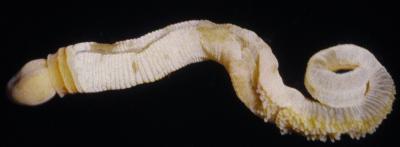[dropcap style=”font-size:100px; color:#992211;”]S[/dropcap]trange phallus-shaped creature provides crucial missing link – discovery pushes fossil record back 200 million years.
In other news wife crushes scientist husband; “for a discovery it’s not that big, and while it pays the bills, I don’t want to be there when the ends meet”
Christopher Cameron of the University of Montreal’s Department of Biological Sciences and his colleagues have unearthed a major scientific discovery – a strange phallus-shaped creature they found in Canada’s Burgess Shale fossil beds, located in Yoho National Park. The fossils were found in an area of shale beds that are 505 million years old.
 Their study, to be published online in the journal Nature on March 13, 2013, confirms Spartobranchus tenuis is a member of the acorn worms group which are seldom-seen animals that thrive today in the fine sands and mud of shallow and deeper waters.
Their study, to be published online in the journal Nature on March 13, 2013, confirms Spartobranchus tenuis is a member of the acorn worms group which are seldom-seen animals that thrive today in the fine sands and mud of shallow and deeper waters.
[quote]Spartobranchus tenuis
probably fed on small
particles of matter filtered
from the seawater.[/quote]Acorn worms are themselves part of the hemichordates, a group of marine animals closely related to today’s sea stars and sea urchins. “Unlike animals with hard parts including teeth, scales and bones, these worms were soft-bodied, so their fossil record is extremely rare,” said author Dr. Chris Cameron of the University of Montreal.
“Our description of Spartobranchus tenuis, a creature previously unknown to science, pushes the fossil record of the enteropneusts back 200 million years to the Cambrian period, fundamentally changing our understanding of biodiversity from this period.”
Since their discovery in the 19th-century, some of the biggest questions in hemichordate evolution have focused on the group’s origins and the relationship between its two main branches: the enteropneusts and the pterobranchs, including graptolites.
“One of the big punchlines from my graduate work, was molecular evidence that enteropneusts and pterobranchs are closely related” said Cameron, a specialist on the taxonomy, evolution and biogeography of hemichordates.
 “It’s astonishing how similar Spartobranchus tenuis fossils are to modern day acorn worms, except that they also formed fibrous tubes.”
“It’s astonishing how similar Spartobranchus tenuis fossils are to modern day acorn worms, except that they also formed fibrous tubes.”
The tubes provide a key missing link that connects the two main hemichordate groups. “The explosive radiation of graptolites in the Paleozoic planktonic ecosystems is known only from the diversity of their tubes. Our findings suggest that the tubes were lost in the lineage leading to modern day enteropneusts, but elaborated on in graptolites and retained to the present day in pterobranchs” added Cameron.
Hemichordates also share many of the same characteristics as chordates – a group of animals that includes humans – with the name hemichordate roughly translating to ‘half a chordate.’
“Work from my lab has shown that enteropneusts filter feed using a pharynx perforated with gill slits, just like the invertebrate chordates” added Cameron.
Spartobranchus tenuis probably fed on small particles of matter filtered from the seawater.
“There are thousands of specimens at the Walcott Quarry in Yoho National Park, so it’s possible Spartobranchus tenuis may have played an important role in moving carbon from the water column to the sediment in the early Burgess Shale environment” said Cameron.
Detailed analysis suggests Spartobranchus tenuis had a flexible body consisting of a short proboscis, collar and narrow elongate trunk terminating in a bulbous structure, which may have served as an anchor. The largest complete specimens examined were 10 centimetres long with the proboscis accounting for about half a centimetre.
A large proportion of these worms was preserved in tubes, of which some were branched, suggesting the tubes were used as a dwelling structure.
Other members of the Spartobranchus tenuis research team are lead author Jean-Bernard Caron of the Royal Ontario Museum and Simon Conway Morris of the University of Cambridge.
About the Burgess Shale
The Burgess Shale is found in Yoho National Park, part of the Canadian Rocky Mountain Parks World Heritage Site, and is one of the most important fossil deposits for understanding the origin and early evolution of animals that took place during the Cambrian Explosion starting about 542 million years ago.
Image 1: Two individuals of Harrimania planktophilus, a modern enteropneust (harrimaniid) worm. This proboscis is to the left. The total length of a relaxed and uncoiled animal is approximately 32 mm. Credit: Photo: C.B. Cameron, Université de Montréal
Image 2:

The aim of art is to represent not the outward appearance of things, but their inward significance. – Aristotle



















